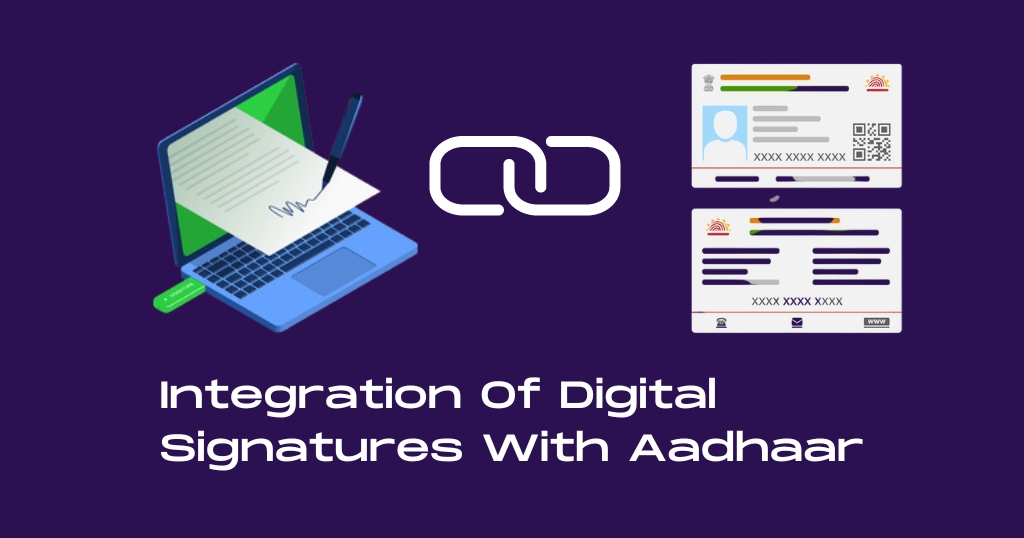In recent years, the integration of digital signatures with Aadhaar, India’s biometric identification system, has emerged as a significant milestone in the country’s efforts to digitize processes and enhance security in online transactions. Aadhaar, a 12-digit unique identification number issued by the Unique Identification Authority of India (UIDAI), has revolutionized the way individuals prove their identity. When combined with digital signatures, Aadhaar brings an added layer of authenticity and trust to digital documents and transactions. In this blog post, we will explore the integration of digital signatures with Aadhaar, its benefits, and its impact on various sectors.
Aadhaar: A Foundation For Digital Identity Verification
Aadhaar has been instrumental in establishing a reliable and robust identity verification system in India. It captures an individual’s biometric and demographic information, including fingerprints, iris scans, and personal details. Aadhaar acts as a unique identifier, providing a secure foundation for various applications and services.
Digital Signatures: The Key To Authenticating Digital Documents
Digital signatures are cryptographic techniques used to verify the integrity, authenticity, and non-repudiation of electronic documents. They are the digital equivalent of traditional handwritten signatures. Digital signatures rely on public-key cryptography, ensuring that the signed document cannot be altered without detection and that the signature is unique to the signatory.
Integration Of Digital Signatures With Aadhaar: Strengthening Trust And Security
The integration of digital signatures with Aadhaar enables individuals to sign electronic documents using their Aadhaar credentials. This integration leverages Aadhaar’s biometric authentication and the underlying cryptographic infrastructure of digital signatures, combining two powerful technologies to enhance security and trust in digital transactions.
Benefits Of Integration
The integration of digital signatures with Aadhaar offers several key benefits:
- Strong Authentication: Aadhaar’s biometric authentication adds an extra layer of security to digital signatures. It ensures that the signatory’s identity is verified using their unique biometric traits, such as fingerprints or iris scans, reducing the risk of impersonation or fraud.
- Legal Validity: Digital signatures integrated with Aadhaar hold legal validity under the Information Technology Act, 2000. The integration reinforces the legal enforceability of digital signatures, making them legally binding and admissible in court.
- Convenience and Efficiency: Aadhaar-integrated digital signatures simplify and streamline the signing process. Individuals can sign documents electronically using their Aadhaar credentials, eliminating the need for physical presence or additional authentication methods. This convenience accelerates processes, reduces paperwork, and enhances overall efficiency.
- Enhanced Security and Integrity: The integration ensures the integrity of the signed documents, providing assurance that they have not been tampered with during transmission or storage. This security feature is crucial for sensitive documents such as contracts, financial agreements, or legal papers.
- Cost Reduction: The adoption of digital signatures with Aadhaar integration reduces costs associated with printing, scanning, courier services, and physical storage of documents. It promotes paperless workflows, saving time and resources for individuals and organizations.
Impact Across Sectors:
The integration of digital signatures with Aadhaar has had a transformative impact on various sectors:
- Government Services: Aadhaar-integrated digital signatures have facilitated the digitization of government services, enabling citizens to sign online forms, applications, and declarations securely. This integration has streamlined processes, reduced bureaucracy, and improved service delivery.
- Banking and Finance: The financial sector has embraced Aadhaar-integrated digital signatures for customer onboarding, loan agreements, digital payments, and other financial transactions. This integration ensures secure and legally valid documentation, simplifying financial processes and improving customer experiences.
- Legal and Judicial System: Digital signatures integrated with Aadhaar have been widely adopted in the legal and judicial system. Lawyers, judges, and litigants can sign and authenticate legal documents electronically, reducing paperwork, time delays, and administrative burdens.
- Business Transactions: Aadhaar-integrated digital signatures have transformed business transactions, enabling organizations to sign contracts, invoices, and other business documents electronically. This integration enhances efficiency, expedites deal closures, and strengthens trust between business partners.
Data Privacy And Security Measures
To address concerns related to data privacy and security, the UIDAI has implemented stringent measures to protect Aadhaar information. These measures include robust encryption algorithms, secure storage, strict access controls, and regular audits to ensure compliance with data protection regulations.
Conclusion
The integration of digital signatures with Aadhaar has revolutionized the way individuals and organizations authenticate digital documents in India. By combining Aadhaar’s biometric authentication with the cryptographic security of digital signatures, the integration ensures strong authentication, legal validity, convenience, enhanced security, and cost reduction. As more sectors adopt Aadhaar-integrated digital signatures, we can expect increased efficiency, streamlined processes, and greater trust in digital transactions, further advancing India’s journey towards a digital economy.
Suggested Blog:
- Process Of Obtaining A Digital Signature Certificate (Dsc) In India
- How To Give Ad In Newspaper For Name Change?
- what is Stamp paper value for partnership deed agreement
- How to Avoid Paying Stamp Duty on Second Property in India?
Written by Meera
